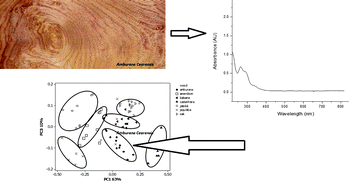Multivariate analyses of UV-Vis absorption spectral data from cachaça wood extracts: a model to classify aged Brazilian cachaças according to the wood species used†
Abstract
Multivariate analyses of

* Corresponding authors
a
Departamento de Química e Física Molecular, Instituto de Química de São Carlos, Universidade de São Paulo (USP), Avenida Trabalhador São-carlense 400, CP 780, CEP 13560-970 São Carlos, SP, Brazil
E-mail:
douglas@iqsc.usp.br
b Ghent University, Faculty of Pharmaceutical Sciences, Harelbekestraat 72, 9000 Ghent, Belgium
Multivariate analyses of

 Please wait while we load your content...
Something went wrong. Try again?
Please wait while we load your content...
Something went wrong. Try again?
A. A. da Silva, D. De Keukeleire, D. R. Cardoso and D. W. Franco, Anal. Methods, 2012, 4, 642 DOI: 10.1039/C2AY05670D
To request permission to reproduce material from this article, please go to the Copyright Clearance Center request page.
If you are an author contributing to an RSC publication, you do not need to request permission provided correct acknowledgement is given.
If you are the author of this article, you do not need to request permission to reproduce figures and diagrams provided correct acknowledgement is given. If you want to reproduce the whole article in a third-party publication (excluding your thesis/dissertation for which permission is not required) please go to the Copyright Clearance Center request page.
Read more about how to correctly acknowledge RSC content.
 Fetching data from CrossRef.
Fetching data from CrossRef.
This may take some time to load.
Loading related content
